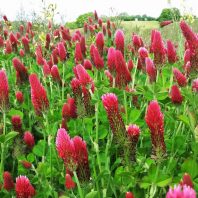This is crimson clover and it’s not just a pretty face. It’s the power engine behind green and luscious crops. Its roots have formed an association with bacteria in the soil microflora. The bacteria, Rhizobium, are able to fix nitrogen from the atmosphere – the air is made up of 80% nitrogen. Nodules on the roots hold the nitrogen in solid form that crops can then take up. Nitrogen is the element that substantially makes stems and leaves: healthy luscious plants. Nitrogen brings fertility. Crimson clover is a green manure.
There’s conventional growing, conventional organic growing, and then there’s vegan or stock-free organic growing. The first two use green manure but rely on nitrogen from animal sources, that’s to say manure, hoof, horn, blood, all by-products of livestock farming, or chemically produced in a factory. The last has no animal inputs. This is why I came to Tolhurst Organic on a three-month internship: to learn from Iain Tolhurst (Tolly) his methods for improving soil fertility without the use of animal (or, obviously, chemical) inputs.
I’ve learnt that it’s a systems approach, an inter-related set of practices and awarenesses, that ensures healthy, nutritious and tasty food free from the pesticides of conventional farming. For Tolly, prime motivations are carbon-reducing and freedom from many of the nasties in animal by-products (eg pathogens such as E. coli, or medications such as antibiotics, found even in organic herds). See his fuller explanation here on the Tolhurst Organic website. For me, the prime motivation is to have food free from the taint of slaughter: peaceful food. We are what we eat.
Some key aspects of the systems approach in stock-free organic farming:
Rotation means growing crops from different plant families in each plot in successive years to avoid soil borne diseases becoming established.
Extended leys or fallows when the land is sown with rye grass or other green manures such as white and red clovers, chicory, field beans, field radish and many others. A Tolly innovation is to undersow and intercrop produce with green manures to have their magic work longer.
Wild flowers mixed with green manures bring pollinators and pest predators.
Beetle banks and hedgerows link up and provide refuge for beneficial insects. The farm is teeming with insects! And therefore birds.
Wood chip compost to introduce fungal mycelium – kilometres of alive thread linking life underground. Working here you do feel connection with a very vital web of life, from tiny bacteria to the two metre spanned red kites overhead.
Minimal cultivation of soil to preserve the many universes of fertility-producing life present in each cubic metre of soil.
Working with Tolly and the team I’ve learned so much about growing on a commercial scale. It’s been enormous fun on a human level. In addition, there’s a very special landscape here: ancient meadow with 200+ species to do yoga practice in, the cool Thames for a post-work dip, mixed woodland, and soft Chiltern hills and site of an Iron Age fort.
A lot of inspiration for Viveka Gardens.
